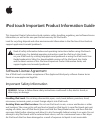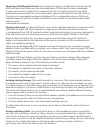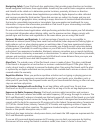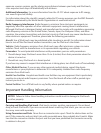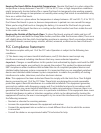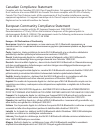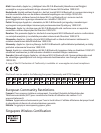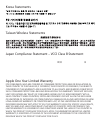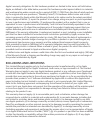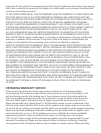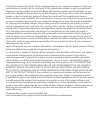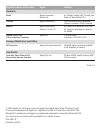Navigating Safely If your iPod touch has applications that provide maps, directions or location-
based navigation assistance, these applications should only be used for basic navigation assistance
and should not be relied on to determine precise locations, proximity, distance or direction.
Maps, directions and location-based applications provided by Apple depend on data collected
and services provided by third parties. These data services are subject to change and may not
be available in all geographic areas, resulting in maps, directions or location-based information
that may be unavailable, inaccurate or incomplete. See www.apple.com/ipodtouch for more
information. Compare the information provided on iPod touch to your surroundings and defer
to posted signs to resolve any discrepancies.
Do not use location-based applications while performing activities that require your full attention.
For important information about driving safety, see the previous section. Always comply with
posted signs and the laws and regulations in the areas where you are using iPod touch.
Seizures, Blackouts, and Eyestrain A small percentage of people may be susceptible to
blackouts or seizures (even if they have never had one before) when exposed to ashing lights or
light patterns such as when playing games or watching video. If you have experienced seizures
or blackouts or have a family history of such occurrences, you should consult a physician before
playing games (if available) or watching videos on your iPod touch. Discontinue use and consult
a physician if you experience headaches, blackouts, seizures, convulsion, eye or muscle twitching,
loss of awareness, involuntary movement, or disorientation. To reduce risk of headaches, blackouts,
seizures, and eyestrain, avoid prolonged use, hold iPod touch some distance from your eyes, use
iPod touch in a well lit room and take frequent breaks.
Glass Parts The outside cover of the iPod touch screen is made of glass. This glass could break
if iPod touch is dropped on a hard surface or receives a substantial impact. If the glass chips or
cracks, do not touch or attempt to remove the broken glass. Stop using iPod touch until the glass
is replaced by an Apple authorized service provider. Glass cracked due to misuse or abuse is not
covered under the warranty.
Repetitive Motion When you perform repetitive activities such as typing or playing games on
iPod touch, you may experience occasional discomfort in your hands, arms, shoulders, neck, or
other parts of your body. Take frequent breaks and if you have discomfort during or after such use,
stop use and see a physician.
For Vehicles Equipped with an Air Bag An air bag inates with great force. Do not store
iPod touch or any of its accessories in the area over the air bag or in the air bag deployment area.
Exposure to Radio Frequency Energy iPod touch contains radio transmitters and receivers.
When on, iPod touch receives and sends out radio frequency (RF) energy through its antenna. The
Wi-Fi and Bluetooth® antenna is located near the back upper left corner of iPod touch as you hold
the end containing the dock connector facing down. iPod touch is designed and manufactured to
comply with the limits for exposure to RF energy set by the Federal Communications Commission
(FCC) of the United States, Industry Canada (IC) of Canada, and regulating entities of Japan, the
European Union, and other countries. The exposure standard employs a unit of measurement
known as the specic absorption rate, or SAR.
iPod touch has been tested as a body-worn device, and meets the SAR exposure requirements for
Wi-Fi and Bluetooth operation.
If you are still concerned about exposure to RF energy, you can limit your exposure by limiting
the amount of time using iPod touch in wireless mode, since time is a factor in how much



